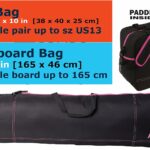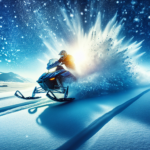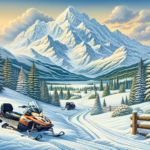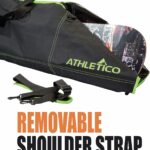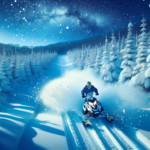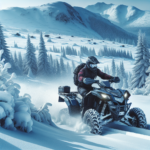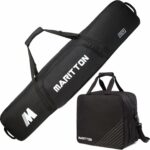As you get ready to hit the powdery trails this winters, snowmobiling can certainly pique your interest. The exhilaration it offers with a zippy ride through the snowy landscapes is truly one-of-a-kind. This particular article, “What To Know About Snowmobiling”, is your ticket to understanding the nitty-gritty of this winter sport. Equipping yourself with knowledge about its history, the vital safety measures and few vital tips to improve your snowmobiling experience: this piece has got it all covered for you.
History of Snowmobiling
You might be wondering how this exciting winter sport came to be, so let’s take a dive into the history of snowmobiling!
Origins and Invention
The concept of a motorized sled came about in the 20th Century, the earliest predecessor of the snowmobile being a winter car developed in 1905 by a Russian inventor. However, the first patent for what you would recognize today as a snowmobile (or more precisely, a “motor toboggan”) was not granted until 1927. Carl Eliason from Sayner, Wisconsin, was credited with this invention, making his creation from parts of a bicycle, a pair of skis, and the motor of a Model T.
Evolution Over the Years
The invention by Eliason was just the start. After World War II, manufacturing companies started producing snowmobiles on a larger scale, introducing major technological upgrades like lightweight materials and improved engines. By the 1950s, commercial models of snowmobiles became available, and their evolution continued with more focus on comfort, speed, and utility until they became the sleek, modern machines you see today.
Impact on Winter Sports and Traveling
Snowmobiling has undeniably made a huge impact on winter sports and travel. It’s not just a recreational activity but also a practical means of transportation in areas with high snowfall. People began using snowmobiles for daily commuting in remote, snowbound regions. The sport rapidly gained popularity in the mid-20th century and continues to be a major winter sport, with snowmobile races drawing large crowds every year.
Types of Snowmobiles
However, not all snowmobiles are created equal. There are different types, each designed for a specific riding style or purpose.
Trail Snowmobiles
These are your standard snowmobiles, designed for cruising on groomed trails. They’re generally easy to handle and have a comfortable suspension to make your ride as smooth as possible.
Performance Snowmobiles
If speed and thrills are what you seek, then performance snowmobiles are for you. They’re built for the adrenaline junkies, boasting powerful engines and a stiffer suspension to handle high speed and aggressive riding.
Utility Snowmobiles
Utility snowmobiles are workhorses, designed for rugged use off the trails. Think of them as the pick-up trucks of snowmobiling. They’re perfect for hauling loads, ice fishing, or performing tasks around the property.
Touring Snowmobiles
If long, leisurely rides are your thing, then touring snowmobiles are built for that purpose. They have extra room for a second rider, adjustable backrests, large fuel tanks, and other amenities for long-distance travel.
Crossover Snowmobiles
As the name suggests, these offer the best of both trail and off-trail designs. They’re versatile and ideal for riders who enjoy both groomed trails and making their own paths through the deep snow.
Understanding Snowmobile Terminology
Before you hit the trails, it’s important to familiarize yourself with some common terminology related to snowmobiling.
Commonly Used Terms
“Sled” is a colloquial term for a snowmobile. You might also hear terms like “powder” (fresh snow), “groomer” (a machine that prepares trails), “boondocking” (off-trail snowmobiling in deep snow), and “flatlander” (a person who rides primarily on flat, groomed trails).
Parts of a Snowmobile
It’s beneficial to know common parts of a snowmobile. The “track” is the continuous belt that propels and steers the machine, while the “skis” help with steering the sled. The “clutch” connects the engine to the track, and the “carbides,” metal runners located on the underside of the skis, help with steering on icy trails.
Types of Snowmobile Tracks
Snowmobile tracks come in different sizes and shapes for various snow conditions and types of riding. The “lug” of the track refers to the height of the tread – higher lugs are better for deep snow, whereas lower lugs perform better on groomed trails.
Snowmobiling Gear and Apparel
Just as crucial as understanding your sled is gearing up properly for a ride.
Essential Clothing
Dressing warmly is essential when snowmobiling. It would be best to wear a snowmobile suit or separate insulated jacket and bib-style pants, winter boots, a snug helmet, gloves or mittens, and goggles.
Recommended Gear
Additional gear can enhance your snowmobiling experience. Consider a neck warmer or balaclava, hand and foot warmers, and snowmobile-specific socks and boots for extra warmth. You may also want to use communicators for easy conversations with your riding group.
Safety Equipment
Don’t forget about safety! A first-aid kit, GPS or compass, snow shovel, and headlamp are all crucial for snowmobiling especially when off-trail. It’s also a good idea to carry a toolkit for any on-the-fly repairs.
Maintenance Tools
Regular maintenance of your sled can prolong its lifespan. Essential maintenance tools include wrenches, a spark plug, a drive belt, and a track tension gauge.
Preparation and Safety Measures
Let’s move on to preparing for a safe and enjoyable ride.
Checking Weather Conditions
Always check the weather forecast before hitting the trails. Severe weather conditions can turn a fun ride into a dangerous situation.
Pre-ride Checklist
Before each ride, do a quick check of your snowmobile. Check the oil and gas levels, inspect the brakes and throttle for proper operation, check the headlights and taillights, and inspect the ski runners and track for wear and tear.
Accident Prevention
Many accidents can be avoided. Stay on marked trails, always ride with a buddy, avoid frozen lakes and rivers, and remember that alcohol and snowmobiling don’t mix.
Survival Skills and First Aid
In case of an emergency, it’s important to know basic survival skills. This includes building a shelter, starting a fire, and signaling for help. It’s also beneficial to have a basic understanding of first aid, including how to treat hypothermia and frostbite.
Riding Basics and Techniques
Now that all the safety measures are in place, let’s get into the fun part: riding!
Starting and Stopping
To start your snowmobile, simply turn the key and give the throttle a slow, steady squeeze. To stop, release the throttle and apply the brake as necessary.
Turning and Balancing
Leaning into a turn helps maintain balance. Always look in the direction you want to go. Weight distribution is key to maintaining control, especially on uneven terrain or when making sharp turns.
Riding Uphill and Downhill
When riding uphill, lean forward to shift your weight to the front of the machine. When going downhill, do the opposite and lean back. Always maintain a steady speed.
Dealing with Obstacles
When confronted with obstacles like logs or rocks, approach at a right angle and at a slow speed. If crossing a slope, keep your speed constant and lean uphill.
Snowmobiling Etiquette and Laws
Being considerate of others and staying on the right side of the law are essential for a safe and enjoyable snowmobiling experience.
Respecting Environment
Always respect the environment. Stay on marked trails to prevent damage to plant and animal life. Don’t litter and minimize noise pollution as much as possible.
Trail Etiquette
Follow the ‘right of way’ rules – those going uphill have the right of way compared to those going downhill. Avoid stopping on the trail, and if you need to, move your snowmobile off to the side.
Legal Requirements and Licensing
Licensing requirements for snowmobiles vary by jurisdiction. Make sure you’re familiar with the rules in your area. You may need to register your sled and have a valid driver’s license or snowmobile-specific license.
Safe Riding Practices
Ride responsibly! Don’t exceed your skill level, always maintain a safe speed, and never ride under the influence of alcohol or drugs.
Where and How to Learn Snowmobiling
If you’re a beginner or need a refresher, you have various options on where to learn how to snowmobile.
Beginner’s Courses
Many areas offer beginner’s courses that cover everything from basic mechanics to riding techniques. Check with local snowmobile clubs, recreation departments, or outfitters for information.
Online Tutorials
There are also plenty of online resources and tutorials that can provide tips and techniques. Just remember, nothing beats hands-on instruction and practice.
Hands-on Training
Many tour operators and instructors offer hands-on training where you can learn to control a snowmobile in a controlled and safe environment before venturing out on the open trails.
Mentorship and Groups
Joining a club or finding a mentor can also be incredibly beneficial. Experienced riders can offer valuable tips and guidance to help you improve your riding skills.
Best Destinations for Snowmobiling
Let’s talk about where you can get out there and enjoy this fantastic sport.
Top Countries for Snowmobiling
Canada and the northern United States are renowned for their snowmobiling trails, thanks to abundant snowfall and extensive trail systems. But places like Sweden, Finland, and even Japan also offer fantastic riding experiences.
Famous Snowmobile Trails
Some famous trails include the Golden Snowmobile Trails in British Columbia, Canada, the Hatfield-McCoy Trails in West Virginia, USA, and the Riksgränsen area in Sweden. Each provides varied terrain and stunning scenery.
Challenging Terrains for Experienced Riders
Experienced riders seeking a challenge can find terrains with steep slopes, deep powder, and rugged landscapes in places like the Rocky Mountains, the Finnish Lapland, or the Hokkaido region in Japan.
Snowmobiling as a Sport and Competition
Lastly, Snowmobiling isn’t just a leisure activity – it’s also a competitive sport.
Brief on Professional Snowmobiling
Competitive snowmobiling includes various types of races, including cross-country, hill climbs, and freestyle events. It requires skill, courage, and a properly tuned and maintained sled.
Popular Snowmobiling Competitions
Some of the biggest competitions include the Winter X Games, the International 500 Snowmobile Race, and the World Championship Snowmobile Derby. They attract the best riders from around the globe.
Training and Sponsorship for Competitions
If you’re interested in competitive snowmobiling, training is crucial. Many top riders have coaches and train extensively in the off-season. Sponsorships can help cover costs associated with training, travel, and equipment.
Snowmobiling is an exhilarating winter sport, blending thrills, skills, and the joy of nature’s wonder. Whether you’re a beginner just getting your bearings or an expert carving your own path, we hope this guide helps you get the most out of your snowmobile adventures. Remember, safety first, and happy riding!
- What Snowboard Bindings Should I Get? - January 23, 2024
- What Size Screws For Snowboard Bindings? - January 23, 2024
- How To Snowmobile On Water? - January 23, 2024

